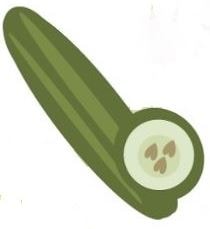 Downy mildew (DM) caused by the oomycete pathogen Pseudoperonospora cubensis is an important disease of cucumber and other cucurbits. Many quantitative trait loci (QTL) have been identified from different resistant resources but very few have been fine mapped or cloned. CucCAP researchers in USDA-ARS and the University of Wisconsin Madison reported identification and functional characterization of the candidate gene for the major-effect QTL, dm5.3 for DM resistance originated from the plant introduction line PI 197088. They performed marker-assisted backcrossing and developed near isogenic lines (NILs) for this QTL that enables to separate its effect from DM resistance from other QTL. Extensive molecular maker analysis and disease screening in both growth chamber and field trials allowed to narrow the dm5.3 gene down to a small region. The evidence they gathered supports CsSIB1 as the candidate gene for dm5.3 QTL that encodes the VQ motif-containing sigma factor binding protein 1. They further identified a haplotype of Indian origin that consists of 7 SNPs inside the coding and promoter region of CsSIB1 that is associated with DM resistance. The expression of CsSIB1 increases upon DM pathogen infection. They performed transcriptome analysis in NILs and found that increased expression of CsSIB1 antagonistically promoted salicylic acid but suppressed jasmonic acid biosynthesis/signaling pathways. This work was supported by the USDA-SCRI CucCAP2 project and has been published in the journal of Theoretical and Applied Genetics.
Downy mildew (DM) caused by the oomycete pathogen Pseudoperonospora cubensis is an important disease of cucumber and other cucurbits. Many quantitative trait loci (QTL) have been identified from different resistant resources but very few have been fine mapped or cloned. CucCAP researchers in USDA-ARS and the University of Wisconsin Madison reported identification and functional characterization of the candidate gene for the major-effect QTL, dm5.3 for DM resistance originated from the plant introduction line PI 197088. They performed marker-assisted backcrossing and developed near isogenic lines (NILs) for this QTL that enables to separate its effect from DM resistance from other QTL. Extensive molecular maker analysis and disease screening in both growth chamber and field trials allowed to narrow the dm5.3 gene down to a small region. The evidence they gathered supports CsSIB1 as the candidate gene for dm5.3 QTL that encodes the VQ motif-containing sigma factor binding protein 1. They further identified a haplotype of Indian origin that consists of 7 SNPs inside the coding and promoter region of CsSIB1 that is associated with DM resistance. The expression of CsSIB1 increases upon DM pathogen infection. They performed transcriptome analysis in NILs and found that increased expression of CsSIB1 antagonistically promoted salicylic acid but suppressed jasmonic acid biosynthesis/signaling pathways. This work was supported by the USDA-SCRI CucCAP2 project and has been published in the journal of Theoretical and Applied Genetics.
View the Article:
- Sigma factor binding protein 1 (CsSIB1) is a putative candidate of the major-effect QTL dm5.3 for downy mildew resistance in cucumber (Cucumis sativus)
by: Junyi Tan, Yuhui Wang, Ronald Dymerski, Zhiming Wu & Yiqun Weng.
Published in Theoretical and Applied Genetics in September 2022.
DOI: 10.1007/s00122-022-04212-x
